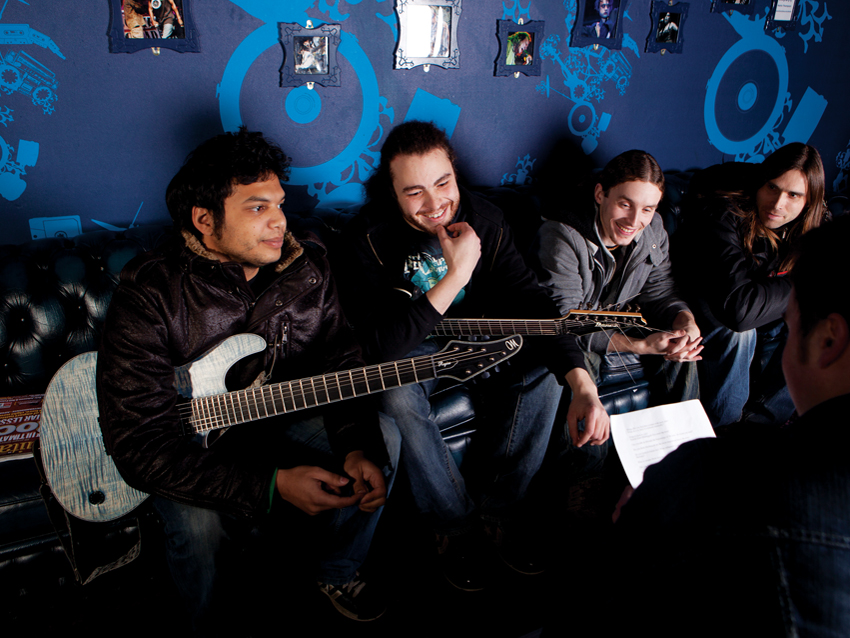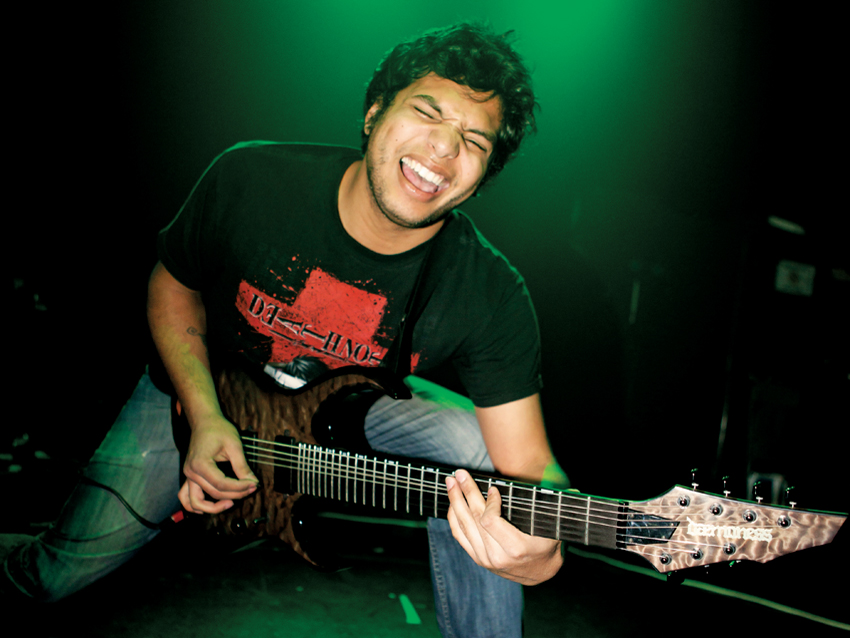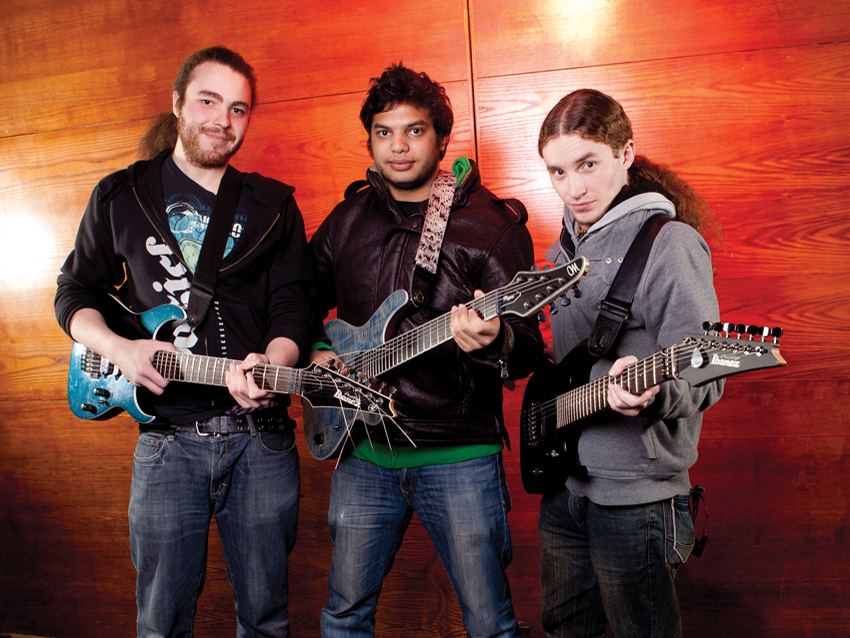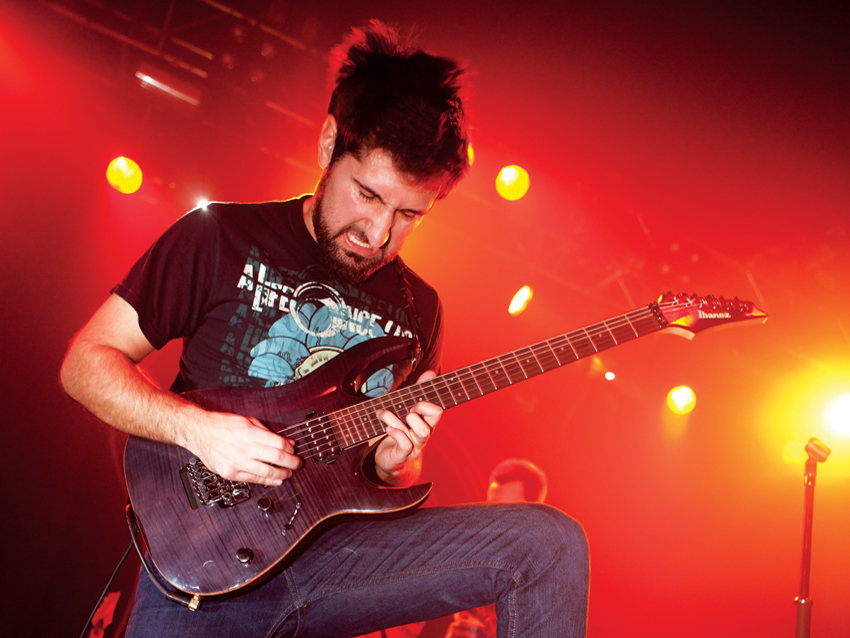What is djent?

What is djent?

What is djent?

What is djent?

What is djent?

What is djent?

What is djent?
"That's a first," TesseracT's vocalist Dan Tompkins informs us as he looks on at the three men excitedly comparing their guitars on the couch - Misha Mansoor of US band Periphery, plus Brits Acle Kahney from TesseracT and Monuments man John Browne. He's right. TG has brought about the first ever djent guitarist summit in Bristol today. In person, anyway…
"We've known about each other and talked online for six years," says Misha. "We've always talked about this, but now it's finally happening!"
This is the first date of the UK League Of Extraordinary Djentlemen tour (djenius pun) that's carrying with it a sense that something very special is happening in metal.These three progressive bands that make up the bill represent a new wave that's not just exciting for metal guitar playing, but also the way that it's reaching out to fans around the world from such humble beginnings.
As with most 'new' waves or sub-genres in music, there are actually a few years of hard work and experimentation behind djent. But it started with just a chord and a band: all roads lead back to Meshuggah. Whether the Swedish band like it or not, they are the (shuggah) daddies of djent.
"The word 'djent' is onomatopeia for that really hard metallic picking sound of four notes" Periphery's Misha Mansoor
"It's pronounced 'gent' and it's a word that I found on the Meshuggah forum," explains Periphery's affable Misha. "Fredrik [Thordendal, Meshuggah guitarist] was the one who started [using the word]. It was just onomatopoeia for the really hard metallic picking of four notes [a powerchord with an added 5th]. You know the song Soul Burn by Meshuggah? That's the sound."
Soul Burn is the key track from Meshuggah's second full-length, 1995's Destroy Erase Improve - an album so groundbreaking that it blew the minds of other progressive musicians.
Meshuggah were bringing polyrhythms to their thrash metal roots, as drummer Tomas Haake's 4/4 beats laid a foundation for he and the rest of the band to play odd time signature rhythms over as the main riffs.Their aim was to make 'un-groove-able' signatures actually groove. But guitarists Mårten Hagström and Fredrik Thordendal weren't just pushing the metal envelope rhythmically; the latter player's love of fusion maverick Allan Holdsworth brought an otherworldly atmosphere to his solos.
Want all the hottest music and gear news, reviews, deals, features and more, direct to your inbox? Sign up here.
They were also using seven-string guitars and digital modelling in pursuit of a crushing, tight heaviness. Such was their desire to perfect the four-note chunk that would be known as djent, the two would later use eight-string guitars.
Meshuggah had taken metal to a new place, and their innovations in musicality and equipment would set the template for a tone fans would try to emulate. But some went even further.The three guitarists here with TG today would evolve distinct identities. After they got the fabled tone, that is…
"It was a quest!" laughs TesseracT's founder Acle Kahney, who now plays alongside James Monteith. "It was a battle on how to get guitars, pickups and amps that were djenty," adds Misha.
But even before their discussions on Meshuggah's fan forum would lead to their own musical projects, other bands were proving to be equally as bold as Meshuggah in the experimental stakes. It was a now-defunct British band who rose to be one of the first of a new generation of young progressive metallers.
Both Misha and Monuments' John credit Watford's Sikth as an inspiration. The influence of Sikth guitarists Graham 'Pin' Pinney and Dan Weller is especially strong in the former's playing style. An avant-garde approach to composition, riffage and time signatures with prodigious use of tapping and legato saw them dubbed a mathcore band before the djent buzzword was parlance.
This approach was combined with a frenzied dual-vocalist line-up that was present in Acle's first band, Fellsilent (formed in Milton Keynes with John), and now in Monuments. After releasing two critically acclaimed albums, Sikth split due to line-up problems in 2007 but are now regarded as a cult band integral to progressive metal's history.
Meanwhile, Misha, John and Acle were sewing the seeds for their own futures with an online collaboration. "It wasn't the kind of collaboration when you'll hear a song we've worked on," Misha reflects. "But we definitely helped each other out. I've got a lot of help from both Acle and John in the past, for sure."
This is why djent is an online phenomenon - all of its key players started to build fanbases by sharing their own recordings online before they even had touring line-ups.With the record industry in a state of flux, these were DIY operations. But it took time, patience and dedication, as well as talent. "We were trying to get a decent sound out of the most meagre setups you've ever seen," Misha continues.
"One of us would get a new piece of gear and we'd be like, 'Is that good?' It was cool because I hadn't even met these guys, but I trusted their advice and I really liked the music they were putting out. I knew that the stuff that they were into would be conducive to a sound that I would want as well."
At that point Misha was working under the name of Bulb, a one-man project that he still uses to post his music in the SoundClick online music community. Some of his compositions have and continue to be used for his band Periphery.
"John and I had Fellsilent at the time," says Acle. "Then we had projects on the side - Monuments was John's project and TesseracT was mine."
The technology behind the sound
Such is djent's reliance on complex rhythms and the interaction between drums and guitars, the programming of intricate drum samples in different time signatures became integral to writing and recording solo. This is where the three guitarists' online discussions became invaluable.
"In the beginning we all had DFH 1 [Toontrack Drumkit From Hell] - it was just samples of a drum kit," explains John. "You had to load it into Battery [Native Instruments' drum software]. At the time we thought it sounded amazing…"
"John showed me how to load it into Battery," Misha recalls. "I used to run it straight through Reason [recording software], but he taught me how to run it through Battery so my recordings sounded better.
"That happened forever ago. Back then, I had Periphery as an idea, but we weren't performing. John and Acle were performing with Fellsilent before Periphery were performing. But we had these ways of making songs on our own, and appropriated them to our bands. I remember some of their riffs would be like TesseracT riffs and some would be Fellsilent riffs - whatever would fit. I don't think any of us had any huge plan. It just sort of evolved over time."
As technology improved, so did the band's compositions and production skills as they went on to use Toontrack's drum sampling software. While Acle is quick to point out that they weren't looking to build fanbases at the time, interest in their music nevertheless spread.
"We were just nerds and people seemed to dig what we were doing," says Misha. "I don't think any of us realised how much of a following we had."
Their recording 'projects' became recording bands. Fellsilent released their Hidden Worlds debut in 2008 but eventually split into Monuments and TesseracT.Across the pond in Maryland, Misha recruited the musicians who were already fans of his music online, with a touring line-up that now includes guitarists Alex Bois and Jake Bowen to recreate the many layers of Periphery's music live.
From that mutual love of Meshuggah came bands with distinct guitar approaches. "We all evolved down slightly different avenues," says Acle. "It seems to have evolved into a style now," adds Misha. "It really doesn't have a lot to do with one style other than low-tuned, open syncopated notes that Meshuggah probably originated, which we all do but isn't necessarily the focus of any of our bands' sounds."
One thing they do have in common is that they are highly developed rhythm guitarists in a style where the mastery of triplets is a given. They all agree that it's their backgrounds as bedroom studio recordists that have let them play confidently in different time signatures.
"I sat down in front of a metronome with Cubase for hours," says John of his secret for success. "Sometimes I'd sit there for 10 hours a day - forget to eat, sleep and drink! - just trying to improve what I had because it's all in the minute details, like doing a perfect scratch.It was about getting my playing so it flows, and often it's not about the notes you play, it's about what you don't play."
While we must recommend TG readers eat three meals a day, it's clear that dedication pays off. "When you're playing that way you start to focus on parts of your technique that make all the difference in the world," says Misha. "Things you'd never have noticed if you weren't sitting in front of a computer and hearing your playing back. It taught me how to play guitar.
"The one thing all of our bands share is a love of groove. We're not technical for the sake of it. The technical part comes as a result of trying to create cool parts - cool grooves and melodies. The focus is to create something inventive but still something people can nod their heads to. We're not trying to confuse anyone."
Influences and inspiration
Their guitar influences aren't necessarily drawn from the metal world, either. "For me, it's David Gilmour," says Acle. "I like the laid back, chilled out style that you often got with Pink Floyd."
This comes through in a signature part of TesseracT's sound - a distinct layered, delayed, clean sound on their debut, One, which is especially important through the six-part Concealing Fate suite in the middle of the record.
"On the album we have a lower octave and a high octave to give it a glassy sparkle. It was an accidental little trick that I started doing in Fellsilent," says Acle, whose main tuning is a seven-string take on DADGAD (B-flat F B-flat E-flat F B-flat Eb-flat) for a drone-y, ambient feel to the clean parts.
"I like Allan Holdsworth, Guthrie Govan and John Petrucci," says Misha of his inspirations. "And a good friend of mine, Tosin Abasi from Animals As Leaders. I produced and co-wrote the Animals As Leaders album with Tosin. He used to live 10 minutes away from me and I'd learn so much just from watching him. I've never had guitar lessons, but I've become better by hanging around musicians that are way better than I am!"
It's this balance of the progressive influences and musicianship with the melodic that shines on both Periphery's self-titled debut and TesseracT's recently released One (Monuments hope to release their debut later this year). Both TesseracT and Periphery have singers capable of soaring clean vocals, who use aggressive styles more sparingly and effectively as a result.
For the love of POD
The guitar tones are equally dynamic - and a careful balance between those 'djent-ified' high mids, bass and compression-heavy tones that have satisfying clarity and crystalline cleans with delays. But they are often digital. While Misha uses Fractal's Axe-FX Ultra for all his guitar tones live and on record now, all the bands have achieved incredible results using an affordable digital processor: the Line 6 POD.
"We've proved you can get a good tone starting out the way that we did with PODs," says Misha who used a PODXT. "It really goes to show that it isn't what you have but entirely how you use it. You can have a studio with all these crazy preamps and mics - it's whether you know how to use them. A lot of people are trying to buy their problems away. We didn't have a lot to work with…"
"It's definitely about working with the tools that you have," adds Acle. "Yep, and it's about patience," agrees John. Both Acle and John still use POD units for recording work because they prefer the tone.
As the conversation turns to the guys' guitars and preferred pickups, Misha's enthusiasm is infectious: "I'm a gear nerd and a half! I like the DiMarzio Crunch Lab and LiquiFire combo - it's a safe bet. A very djenty pickup combo… I just crucified myself there saying that!
"Bare Knuckle just put out its Aftermath pickup and I think it's one of the best-sounding pickups ever," he continues. "It's a really aggressive, pissed-off sounding pickup with relatively high output but not over the top by Bare Knuckle standards.
"It's very controlled and tight. I've got a few sets at home that I'm going to put into some guitars - I'm a free agent, so I can play whatever I want, but my main endorser is Bernie Rico Jr custom guitars. However, I might put them into one of these Mayones guitars as well."
Acle, meanwhile, looks back to his early influences: "I've got Lundgren pickups in this Ibanez 2127 [Acle's co-guitarist James Monteith uses the same model]. They're Swedish - Meshuggah use the same pickups and they have a hot output but a tight sound."
"The rise of djent and the talented musicianship associated with it is very good news indeed for guitar music."
Seven-string guitars are still an acquired taste, though, as Misha explains: "Don't force it. Get a seven-string and jam around to see what comes out. It's a different instrument. In Periphery, half the album is six and half is seven-string. The way I've always thought about it is, you're jamming around with a riff idea and it kind of evolves from there after recording it. If I had the same idea on a six-string in a parallel dimension it would probably become a completely different song with a different feel.
"It really dictates it - the more note-based material tends to work better on six-strings because it's higher and there's more definition, but lower groove-orientated material works better on seven."
This enthusiasm for tweaking tones and pushing the technical side of metal is clearly a calling card of bands associated with djent. But the scene's openness to young players is also something to celebrate: when he's not touring, writing and recording new music, the prolific Misha can be found answering playing and gear questions from fans on Facebook and YouTube. The scene's bands also actively participate with fan site got-djent.com.
In the last six months the scene has broken out from its online community to touring the world. TesseracT have already played in India. Twice. And Periphery's first ever tour proper was in Australia.
"We kept hearing that there are fans out there," says Misha of plans for global domination. "The scene is constantly growing with patches of fans all over the world. But you don't fully appreciate it until you get out there playing."
No matter where it heads in the future, right now in the world of progressive metal guitar playing, the rise of djent and the talented musicianship associated with it is very good news indeed for guitar music.
Four more djent acts you need to hear:
CHIMP SPANNER: Aka Paul Ortiz, the Brit regarded as a key guitarist in the scene and the master of perfecting POD tone by John, Paul and Acle.
Must-hear track: Supererogation
ANIMALS AS LEADERS: Jaw-dropping eight-string guitarist Tosin Abasi is a maverick: he's djent's Vai. And, yes, Steve is a fan of Abasi's instrumental band.
Must-hear track: Inamorata
VILDHJARTA: There's a lot of anticipation for this Stockholm band's debut, Irreversible. Check out their devastatingly sharp tone and insane rhythm work (ultra-djent?) in the songs they've previewed so far.
Must-hear track: Shiver
HAUNTED SHORES: Misha Mansoor's side-project with Mark Holcomb will appeal to Periphery fans. Their forthcoming debut album features a different vocalist on each song.
Must-hear track: Sentient Glow

Rob is the Reviews Editor for GuitarWorld.com and MusicRadar guitars, so spends most of his waking hours (and beyond) thinking about and trying the latest gear while making sure our reviews team is giving you thorough and honest tests of it. He's worked for guitar mags and sites as a writer and editor for nearly 20 years but still winces at the thought of restringing anything with a Floyd Rose.

